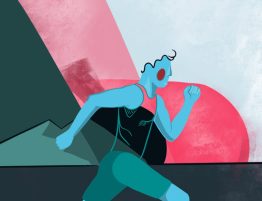
Dr. Deborah Rohm Young’s work might move you – or at least make you think about moving around a bit.
As director of behavioral research in the Kaiser Permanente Southern California Department of Research and Evaluation in Pasadena, Young’s extensive body of work includes many studies about the healthy effects of physical activity – and the problems that come with inactivity. She also led the panel of experts who wrote an American Heart Association science advisory on sedentary behavior in 2016.
Sedentary behavior is formally defined as low energy expenditure while sitting, reclining or lying down. You’re probably familiar with it: Adults in the U.S. spend an average of six to eight hours a day sitting, the AHA advisory pointed out.
Which is not good, Young said. Evidence is growing that sedentary time is associated with a higher risk of developing and dying from cardiovascular disease, a higher risk of Type 2 diabetes and more.
But does she put her findings into action in her own life, or does she take things lying down?
We asked her to discuss sedentary behavior – both scientifically and personally – as part of “The Experts Say,” an American Heart Association News series where specialists explain how they apply what they’ve learned to their own lives.
What got you interested in this area of research?
About 11 years ago, we had some data available from the California Men’s Health Study from Kaiser Permanente, which had questions about both physical activity and sedentary time. There had been so much already published on the benefits of physical activity we thought it would be of interest to examine the opposite.
Since then, we’ve learned, though, that these behaviors are not “opposite,” but completely different. A person can be highly active and also highly sedentary.
How can people overcome the effects of being sedentary?
Those who are the most sedentary are at the greatest risk. The studies suggest that being physically active and sedentary is better than no physical activity and being sedentary, so the current message is simply “sit less, move more.”
A number of studies are starting to show some positive physiological effects from interventions that encourage short bouts of activity during prolonged sitting or screen time.
Are all sedentary behaviors the same? Is sitting and reading a book the same as scrolling social media, driving a car or playing a video game?
I wish we had an answer to this!
Many of the epidemiologic studies have assessed sedentary behavior in different ways, such as time spent sitting, time spent watching TV or time in front of a screen. Some studies have used accelerometry or inclinometers to assess sedentary time.
Evidence pretty consistently points to more sedentary time being associated with adverse health outcomes. What we don’t know yet is how much sedentary time is too much.
How do you monitor and compensate for sedentary behavior in your own life?
Before the pandemic, I was in the office most days. I had a standing desk. My work is now hybrid and I’m mostly at home sitting, though. I do get up a lot and move around – refilling my water bottle multiple times a day, getting lunch and standing during some calls.

Does your day have a lot of movement built into it, or do you have to remind yourself to move?
In my line of work I have to concentrate a lot, so it doesn’t work for me to have an alarm to tell me to get up and move. But that may work for others.
I am a regular walker and am out most mornings for a 45- to 60-minute walk. I have been logging my running (and now walking) miles for years. I set yearly mileage goals but am pretty forgiving of myself if I don’t meet them.
In the evenings, I tend to be up and down off the couch. On weekends, I like to be outside, which usually means moving around and checking what’s going on in the neighborhood. I am an avid weed-puller, and there’s never a shortage of weeds to pull in our yard.
What’s your advice to anyone seeking to find a healthy balance in their own lives?
First, take stock of how much of the day is spent being sedentary. It’s become so ubiquitous in our daily lives that we may not even realize how much time is spent sitting.
Then, figure out what works to try to take breaks or increase physical activity. The best advice is to find the time to be active.



